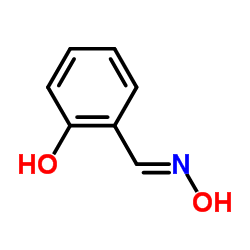salicylaldehyde, oxime

salicylaldehyde, oxime structure
|
Common Name | salicylaldehyde, oxime | ||
|---|---|---|---|---|
| CAS Number | 94-67-7 | Molecular Weight | 137.136 | |
| Density | 1.2±0.1 g/cm3 | Boiling Point | 256.5±23.0 °C at 760 mmHg | |
| Molecular Formula | C7H7NO2 | Melting Point | 59-61 °C(lit.) | |
| MSDS | Chinese USA | Flash Point | 146.9±11.9 °C | |
| Symbol |

GHS07 |
Signal Word | Warning | |
|
Selective and potent agonists for estrogen receptor beta derived from molecular refinements of salicylaldoximes.
Eur. J. Med. Chem. 46 , 2453-62, (2011) In a continuing effort to improve the subtype selectivity and agonist potency of estrogen receptor β (ERβ) ligands, we have designed and developed a thus far unexplored structural series obtained by molecular refinements of monoaryl-substituted salicylaldoxim... |
|
|
Structural evolutions of salicylaldoximes as selective agonists for estrogen receptor beta.
J. Med. Chem. 52 , 858-67, (2009) The bioisosteric replacement of the phenol ring, a signature functional group of most estrogen receptor (ER) ligands, with a hydrogen-bonded pseudocyclic ring, led to the development of a novel class of nonsteroidal ER-ligands based on a salicylaldoxime templ... |
|
|
Linking [M(III)3] triangles with "double-headed" phenolic oximes.
Dalton Trans. 41(29) , 8777-85, (2012) Strapping two salicylaldoxime units together with aliphatic α,Ω-aminomethyl links in the 3-position gives ligands which allow the assembly of the polynuclear complexes [Fe(7)O(2)(OH)(6)(H(2)L1)(3)(py)(6)](BF(4))(5)·6H(2)O·14MeOH (1·6H(2)O·14MeOH), [Fe(6)O(OH)... |
|
|
Phenolic compounds, sodium salicylate and related compounds, as inhibitors of tumor cell growth and inducers of apoptosis in mouse leukemia L1210 cells.
In Vivo 19(1) , 31-5, (2005) The effects of a series of phenolic compounds were compared to the effects of sodium salicylate (2-hydroxybenzoate) on the growth, cell cycle and apoptotic effects in wild-type (WT) and deoxyadenosine-resistant (Y8) L1210 leukemia cells. These compounds inclu... |
|
|
Removal of toxic uranium from synthetic nuclear power reactor effluents using uranyl ion imprinted polymer particles.
Environ. Sci. Technol. 40(9) , 3070-4, (2006) Major quantities of uranium find use as nuclear fuel in nuclear power reactors. In view of the extreme toxicity of uranium and consequent stringent limits fixed by WHO and various national governments, it is essential to remove uranium from nuclear power reac... |
|
|
Oximes as spectrophotometric reagents-a review.
Talanta 26 , 425, (1979) The uses of oximes as spectrophotometric reagents since 1953 are reviewed. |
|
|
Synthesis, biological evaluation, and molecular docking studies of 2,6-dinitro-4-(trifluoromethyl)phenoxysalicylaldoxime derivatives as novel antitubulin agents.
Bioorg. Med. Chem. 20(10) , 3233-41, (2012) A series of 2,6-dinitro-4-(trifluoromethyl)phenoxysalicylaldoxime derivatives (1h-20h) have been designed and synthesized, and their biological activities were also evaluated as potential antiproliferation and tubulin polymerization inhibitors. Among all the ... |
|
|
Salicylaldoxime derivatives as new leads for the development of carbonic anhydrase inhibitors.
Bioorg. Med. Chem. 21(6) , 1511-5, (2013) New compounds containing a novel zinc binding group (salicylaldoxime system) were identified as effective inhibitors of carbonic anhydrases (CAs). This structural motif seems to bind the catalytic zinc ion of CAs, revealing itself as a new valid alternative t... |
|
|
Cation and anion selectivity of zwitterionic salicylaldoxime metal salt extractants.
Dalton Trans. 39(7) , 1763-70, (2010) 3-Dialkylaminomethyl substituted salicylaldoximes are efficient metal salt extractants, and, in contrast to related "salen"-based reagents, are sufficiently stable to acid hydrolysis to allow commercial application in base metal recovery. Crystal structures s... |
|
|
Transport of metal salts by zwitterionic ligands; simple but highly efficient salicylaldoxime extractants.
Chem. Commun. (Camb.) (34) , 4049-51, (2008) Attaching dialkylaminomethyl arms to commercial phenolic oxime copper extractants yields reagents which transport base metal salts very efficiently by forming neutral 1:1 or 1:2 complexes with zwitterionic forms of the ligands. |